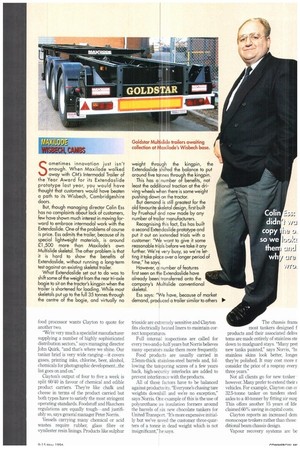S ometimes innovation just isn't enough. When Maxilode walked away with
Page 51

Page 52

If you've noticed an error in this article please click here to report it so we can fix it.
CM'S Intermodal Trailer of the Year Award for its Extendaslide prototype last year, you would have thought that customers would have beaten a path to its Wisbech, Cambridgeshire doors But, though managing director Colin Ess has no complaints about lack of customers, few have shown much interest in moving forward to embrace intermodal work with the Extendaslide. One of the problems of course is price. Ess admits the trailer, because of its special lightweight materials, is around £1,500 more than Maxilode's own Multislicle skeletal. The other problem is that it is hard to show the benefits of Extendaslide, without running a long-term test against an existing skeletal trailer.
What Extendaslide set out to do was to shift some of the weight from the rear tri-axle bogie to sit on the tractor's kingpin when the trailer is shortened for loading. While most skeletals put up to the full 35 tonnes through the centre of the bogie, and virtually no weight through the kingpin, the Extendaslide shifted the balance to put around five tornes through the kingpin. This has a number of benefits, not least the additional traction at the driving wheels when there is some weight pushing down on the tractor.
But demand is still greatest for the old favourite skeletal design, first built by Fruehauf and now made by any number of trailer manufacturers.
Recognising this fact, Ess has built a second Extendaslide prototype and put it out on extended trials with a customer. "We want to give it some reasonable trials before we take it any further. We're vet)/ busy, so we're letting it take place aver a longer period of time," he says.
However, a uumber of features first seen on the Extendaslide have already been transferred onto the company's Multislide conventional skeletal.
Ess says: "We have, because of market demand, produced a trailer similar to others ■ on the market. We didn't want to copy the others so we looked at them and said why are they wrong? So with the Multislide, we've looked at how we can improve the design. We've taken the rollers and locking pins from the Extendaslide to make into the Multislide."
The original prototype Extendaslide used greased sliding pads between the two sections of the trailer—the second model was upgraded to include a track of rollers to cut the Friction when sliding the extending section. These rollers, also seen on Maxilode's topframe trailer, have been well proven on more than 500 of the Firm's trailers to date.
Unlike the opposition, Maxilode's locking system doesn't go through the sides of the trailer horizontally. Instead the firm has come up with a vertical two-pin locking system using cone-end pins to help locate in the holes. When the trailer is extended the pins are only taking braking forces as the Iwo trailer sections pull metal to metal.
But with this twopin system the trailer can also be used in the closed-up position with a maximum load of 15 tonnes.
The lightweight materials on the Extendaslide have not been incorporated into the Multislide because its more basic design already competes well with the 5.3-tonne weight of the competition.
So far Maxilode's best customer For the Multislide has been Goldstar, which has ordered five trailers for its Felixstowe opera
tion and five for the Isle of Grain site. But Ess has not Forgotten that weight balance problem and he is still keen to move some of the weight on to the kingpin. To that end Maxilode is also trialling a Multislide with its wheelbase extended from 8m to 8.5 m.
To cope with the extra turning length this unit has been fitted with a self-tracking rear axle, which also allows it to carry intermodal 13.6m boxes within the permitted tail-swing radius. Ess believes that the extra cost will be offset by reduced tyre wear. The firm's experience with the lightweight steels involved in the Extendaslide has also stood it in good stead now that Ess is looking to broaden his horizons: "Export is just starting to happen for us," he says. This is timely as he predicts a slight downturn in demand From the domestic market.
Maxilode is already using its lightweight steel experience to build intermodal trailers for overseas customers in small numbers, and Ess is going to put the trailers through hornologation for Belgium, Holland and Germany. That's not bad for a company that has only been in business for seven years. Innovation may not be all, but it is certainly helping Maxilode to build its business, making it a worthy winner of Commercial Motor's award.
C. by Dan Gilkes
















































































































